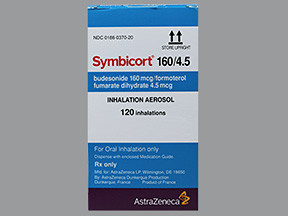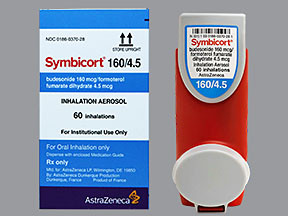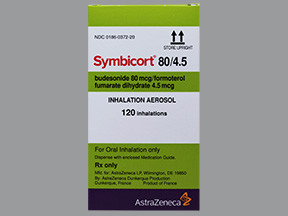BUDESONIDE/FORMOTEROL HFA INHALER - ORAL
PHONETIC PRONUNCIATION: (bue-DES-oh-nide/for-MOE-ter-ol)
COMMON BRAND NAME(S): Symbicort
GENERIC NAME(S): budesonide/formoterol fumarate
Uses
USES: This product is used to control and prevent symptoms (wheezing and shortness of breath) caused by asthma or ongoing lung disease (chronic obstructive pulmonary disease-COPD, which includes chronic bronchitis and emphysema). It contains 2 medications: budesonide and formoterol. Budesonide belongs to a class of drugs known as corticosteroids. It works by reducing the irritation and swelling of the airways. Formoterol belongs to the class of drugs known as long-acting beta agonists. It works by opening airways in the lungs to make breathing easier. Controlling symptoms of breathing problems can decrease time lost from work or school. When used alone, long-acting beta agonists (such as formoterol) may rarely increase the risk of serious (sometimes fatal) asthma-related breathing problems. However, combination inhaled corticosteroid and long-acting beta agonists, such as this product, do not increase the risk of serious asthma-related breathing problems. For asthma treatment, this product should be used when breathing problems are not well controlled with one asthma-control medication (such as inhaled corticosteroid) or if your symptoms need combination treatment. Before using this medication, it is important to learn how to use it properly. This medication must be used regularly to be effective. It does not work right away and should not be used to relieve sudden asthma attacks. If an asthma attack occurs, use your quick-relief inhaler (such as albuterol, also called salbutamol in some countries) as prescribed.
How to use BUDESONIDE/FORMOTEROL HFA INHALER - ORAL
HOW TO USE: Read the Patient Information Leaflet and Instructions for Use provided by your pharmacist before you start using this medication and each time you get a refill. Follow the illustrated directions for the proper use of this medication. If you have any questions, ask your doctor or pharmacist. Follow the instructions for priming the inhaler if you are using it for the first time, if you have not used it for more than 7 days, or if the inhaler was dropped. When priming the inhaler, make sure to spray away from the face so that you do not get the medication into your eyes. Shake the inhaler well for 5 seconds before each use. Inhale this medication by mouth as directed by your doctor, usually twice daily (in the morning and evening, 12 hours apart). If your prescribed dose is 2 puffs, wait at least one minute between them. If you are using other inhalers at the same time, wait at least 1 minute between the use of each medication, and use this drug last. Gargle and rinse your mouth with water after using this medication to help prevent irritation and yeast infections (thrush) in the mouth and throat. Do not swallow the rinse water. Clean the inhaler once a week with a dry cloth. Do not take the inhaler apart. The dosage is based on your medical condition and response to treatment. Use this medication regularly in order to get the most benefit from it. This medication works best if used at evenly spaced times. To help you remember, use it at the same times each day. Do not increase your dose, use this medication more often, or stop using it without first consulting your doctor. Also, do not use other long-acting beta agonists while using this medication. If you are regularly using a different corticosteroid taken by mouth (such as prednisone), you should not stop using it unless directed by your doctor. You may have withdrawal symptoms if the drug is suddenly stopped. Some conditions (such as asthma, allergies) may become worse when the drug is suddenly stopped. To prevent withdrawal symptoms (such as weakness, weight loss, nausea, muscle pain, headache, tiredness, dizziness), your doctor may direct you to slowly lower the dose of your old medication after you begin using this product. Consult your doctor or pharmacist for more details, and report any withdrawal reactions right away. See also Precautions section. If you have been using a quick-relief inhaler (such as albuterol, also called salbutamol in some countries) on a regular daily schedule (such as 4 times daily), you must stop this schedule and only use the quick-relief inhaler as needed for sudden shortness of breath/asthma attacks. Consult your doctor for details. It may take 1 week or longer before you get the full benefit of this drug. Tell your doctor if your symptoms do not improve or if they worsen. Learn which of your inhalers you should use every day (controller drugs) and which you should use if your breathing suddenly worsens (quick-relief drugs). Ask your doctor ahead of time what you should do if you have new or worsening cough or shortness of breath, wheezing, increased sputum, worsening peak flow meter readings, waking up at night with trouble breathing, if you use your quick-relief inhaler more often (more than 2 days a week), or if your quick-relief inhaler does not seem to be working well. Learn when you can treat sudden breathing problems by yourself and when you must get medical help right away.
Side Effects
Precautions
Interactions
Overdose
Images
Reviews
Faq for BUDESONIDE/FORMOTEROL HFA INHALER - ORAL
Budesonide/Formoterol HFA Inhaler is used to treat asthma in patients who require both inhaled corticosteroids and long-acting beta agonists.
This inhaler combines two medications, budesonide (a corticosteroid) and formoterol (a long-acting beta agonist), to help open airways and reduce inflammation in the lungs, making it easier to breathe.
Follow the instructions provided by your healthcare professional. Shake the inhaler well before each use and prime it if it is newly opened or has not been used for a while. Breathe out completely and then place the mouthpiece in your mouth, forming a tight seal. Inhale deeply and slowly while pressing down on the canister to release the medication. Hold your breath for 10 seconds, then breathe out slowly.
Common side effects may include headache, throat irritation, cough, and nasal congestion. More serious side effects can include increased heart rate, high blood pressure, chest pain, or tremors. Consult your doctor if you experience any unusual or severe side effects.
Yes, Budesonide/Formoterol HFA Inhaler can be prescribed for children aged 6 years and older, but under the supervision of a healthcare professional.
It is important to discuss the risks and benefits with your doctor before using this medication if you are pregnant, planning to become pregnant, or breastfeeding.
If you miss a dose, skip it and continue with your regular dosing schedule. Do not double the dose to make up for a missed one.
No, Budesonide/Formoterol HFA Inhaler is not indicated as a rescue inhaler for sudden asthma attacks. It is a maintenance medication to be used regularly to control symptoms and prevent asthma attacks. You should always have a separate rescue inhaler for immediate relief during an asthma attack.
Budesonide/Formoterol HFA Inhaler is available as a brand-name medication called Symbicort. There may also be generic versions available, which contain the same active ingredients.
Disclaimer
IMPORTANT: HOW TO USE THIS INFORMATION: This is a summary and does NOT have all possible information about this product. This information does not assure that this product is safe, effective, or appropriate for you. This information is not individual medical advice and does not substitute for the advice of your health care professional. Always ask your health care professional for complete information about this product and your specific health needs.




No Reviews Yet